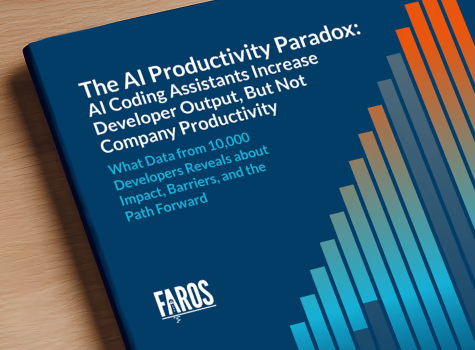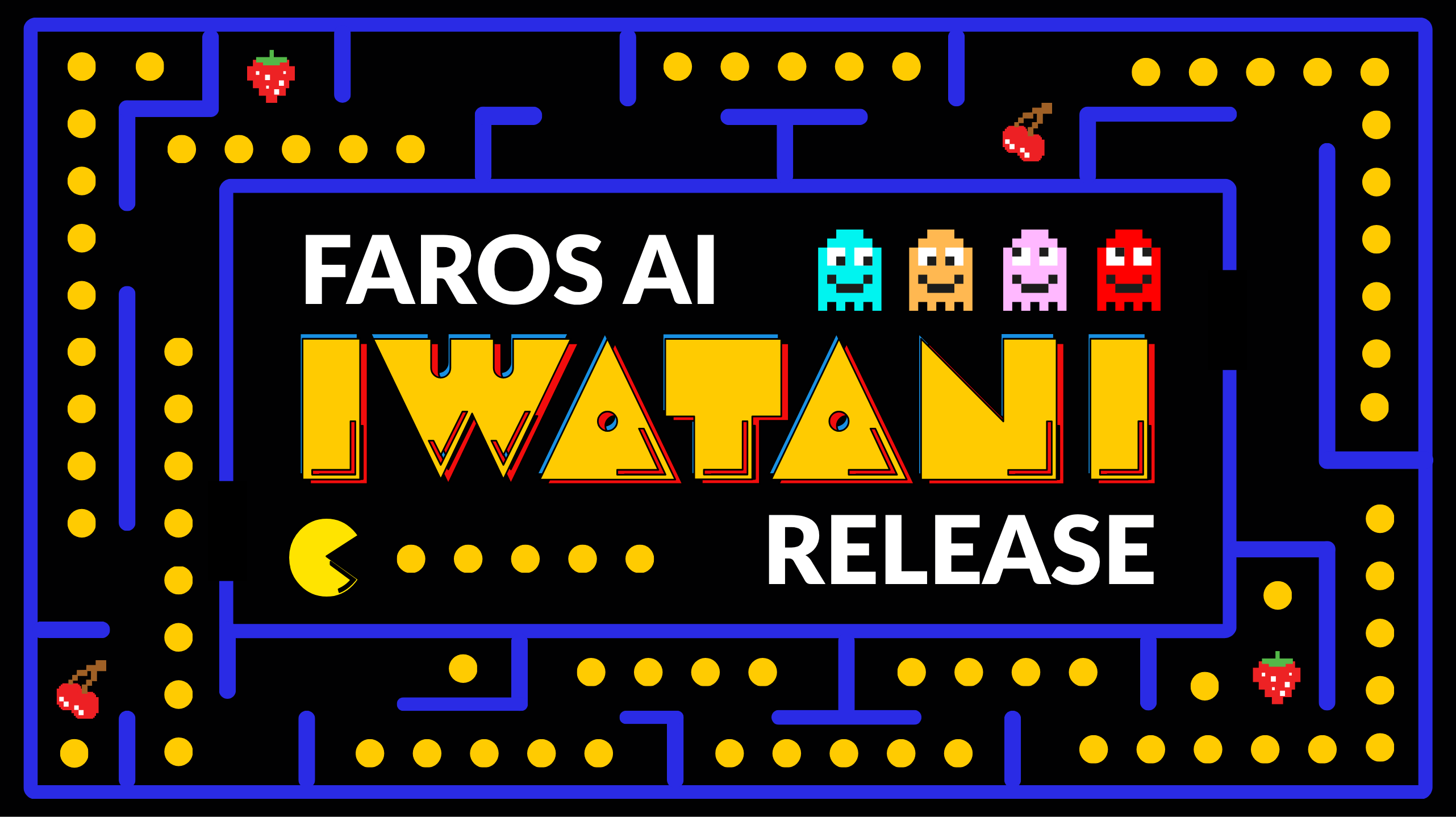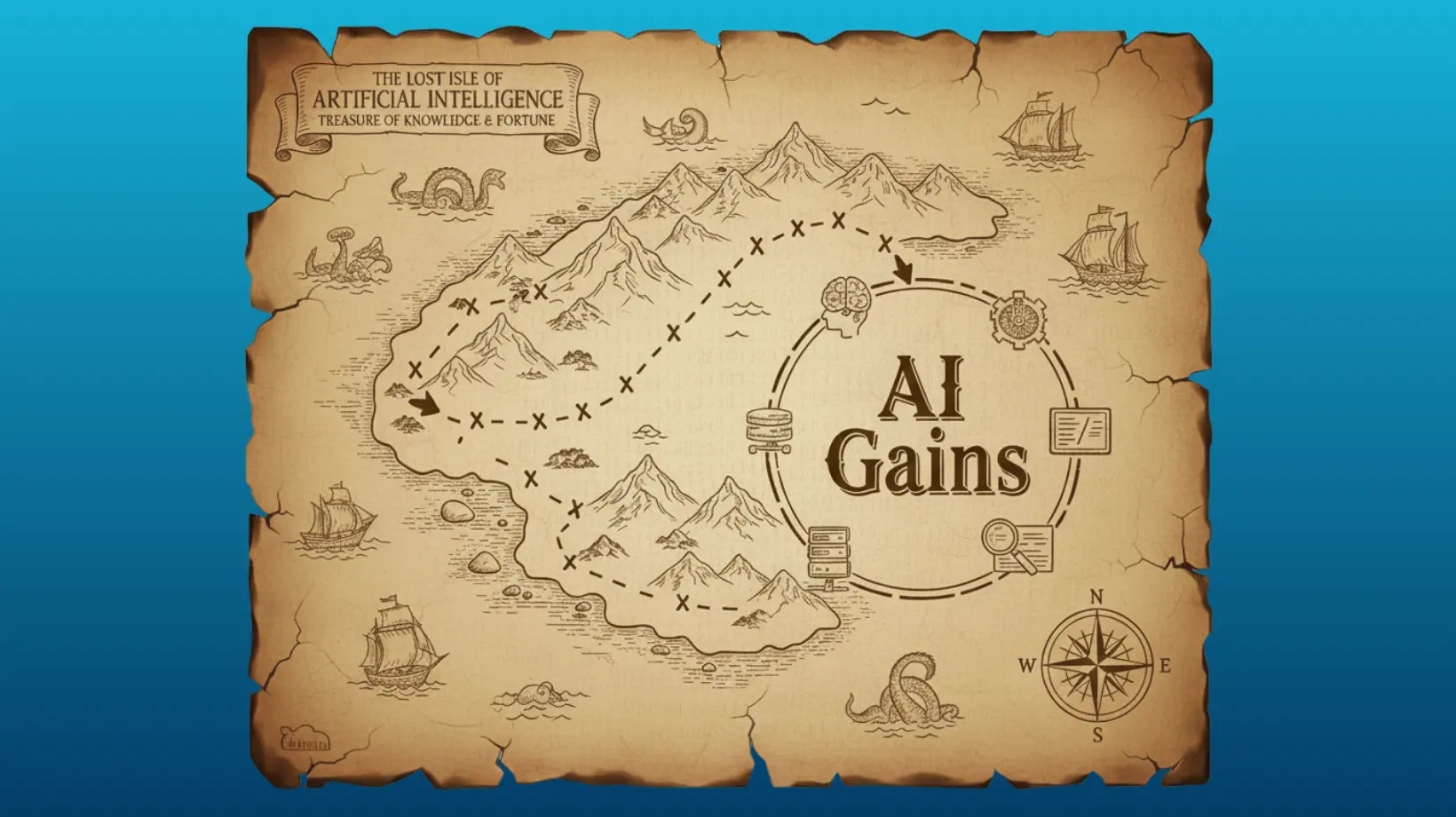Fill out this form to speak to a product expert.
Are AI Coding Assistants Really Saving Time, Money and Effort?
Research from DORA, METR, Bain, GitHub and Faros AI shows AI coding assistant results vary wildly, from 26% faster to 19% slower. We break down what the industry data actually says about saving time, money, and effort, and why some organizations see ROI while others do not.

The gap between feeling faster and being faster
Ninety percent of developers now use AI coding assistants in their daily work. That's a staggering adoption curve for any technology. Yet here's the uncomfortable truth: most organizations see no measurable productivity gains at the company level.
Are AI coding assistants really saving time, money, and effort? The honest answer is: it depends. And the research tells us exactly what it depends on.
The disconnect between individual developer experience and organizational outcomes has a name: the AI Productivity Paradox. Developers feel faster. They report higher satisfaction. But when engineering leaders look at throughput, quality, and delivery velocity, the numbers often tell a different story.
Let's break down what the research actually shows, why individual gains fail to scale, and what separates organizations that see real savings from those stuck in expensive pilot mode.
{{cta}}
What does the research actually show?
The research on AI coding assistant productivity is contradictory. That's not a flaw in the studies. It reflects genuine variation in outcomes based on context, experience, and implementation approach.
The case for savings
Several rigorous studies show meaningful productivity gains. Researchers from Microsoft, MIT, Princeton, and Wharton conducted three randomized controlled trials at Microsoft, Accenture, and a Fortune 100 company involving nearly 4,900 developers. They found a 26% increase in weekly pull requests for developers using GitHub Copilot, with less experienced developers seeing the greatest gains.
A separate GitHub study with Accenture found an 84% increase in successful builds and a 15% higher pull request merge rate among Copilot users.
Google's internal study found developers completed tasks 21% faster with AI assistance. GitHub's research reported tasks completed 55% faster and an 84% increase in successful builds.
The case against
Other studies tell a starkly different story. A July 2025 randomized controlled trial by METR with experienced open-source developers found that when developers used AI tools, they took 19% longer to complete tasks than when working without AI assistance. The Bain Technology Report 2025 found that teams using AI assistants see only 10-15% productivity boosts, and the time saved rarely translates into business value.
Perhaps most revealing: Faros AI's analysis of telemetry from over 10,000 developers across 1,255 teams found that while teams with high AI adoption completed 21% more tasks and merged 98% more pull requests, company-wide delivery metrics remained flat. No measurable organizational impact whatsoever. We termed that The AI Productivity Paradox.
{{ai-paradox}}
What explains the contradiction?
The divergent results make sense when you examine the conditions.
- Experience level matters significantly: junior developers in the Microsoft/Accenture study saw 35-39% speed improvements, while senior developers saw only 8-16% gains.
- Task complexity matters: AI excels at boilerplate code, documentation, and test generation but struggles with complex architectural decisions.
- Codebase familiarity matters: the METR study specifically recruited developers working on repositories they'd contributed to for years, where they already knew the solutions and AI added friction rather than removing it.
Why individual gains don't become organizational improvements
The bottleneck problem
Faros AI's research revealed a critical finding: teams with high AI adoption saw PR review time increase by 91%. AI accelerates code generation, but human reviewers can't keep up with the increased volume. This illustrates Amdahl's Law in practice: a system moves only as fast as its slowest component.
AI-driven coding gains evaporate when review bottlenecks, brittle testing, and slow release pipelines can't match the new velocity. The bottleneck simply shifts downstream. Developers write code faster, but the code sits in review queues longer. Without lifecycle-wide modernization, AI's benefits get neutralized by the constraints that already existed.
The amplification effect
The 2025 DORA Report introduced a powerful framing: AI acts as both "mirror and multiplier." In cohesive organizations with solid foundations, AI boosts efficiency. In fragmented ones, it highlights and amplifies weaknesses.
This means AI doesn't create organizational excellence. It magnifies what already exists. Organizations with strong version control practices, quality internal platforms, and user-centric focus see compounding gains. Organizations with siloed teams, inconsistent processes, and technical debt see amplified chaos.
The perception gap
The METR study uncovered something fascinating about developer psychology. Before starting tasks, developers estimated AI would make them 24% faster. After completing the study (where they were actually 19% slower), they still believed AI had sped them up by roughly 20%. There's a significant gap between how productive AI makes developers feel and how productive it actually makes them.
Without rigorous measurement, organizations can't distinguish perception from reality. Developers report satisfaction and velocity improvements in surveys while delivery metrics remain unchanged. This is why telemetry-based analysis matters more than self-reported productivity gains.
Are AI coding assistants really saving time?
Yes, at the task level for routine work. No, at the organizational level without intentional process change.
Here's where time is genuinely saved: writing boilerplate code, generating documentation, creating test scaffolding, explaining unfamiliar codebases, and refactoring repetitive patterns. For these tasks, AI coding assistants deliver consistent value.
Here's where time is often lost: debugging AI-generated output, retrofitting suggestions to existing architecture, extended code review cycles, and verifying that AI suggestions don't violate patterns established elsewhere in the codebase. For experienced developers working on complex systems they already understand, these costs can exceed the benefits.
The Atlassian 2025 State of DevEx Survey provides important context: developers spend only about 16% of their time actually writing code. AI coding assistants, by definition, can only optimize that 16%. The other 84% of developer time goes to meetings, code review, debugging, waiting for builds, and context switching. AI can't fix those bottlenecks by making code generation faster.
Are AI coding assistants really saving money?
ROI is achievable within 3-6 months, but only with intentional implementation.
The math is compelling on paper. At $19 per month per developer, if an engineer earning $150,000 annually saves just two hours per week through AI assistance, that's roughly $7,500 in recovered productivity per year, a substantial return on investment. GitHub's research shows enterprises typically see measurable returns within 3-6 months of structured adoption.
But the Bain Technology Report 2025 found that most teams see only 10-15% productivity gains that don't translate into business value. The time saved isn't redirected toward higher-value work. It's absorbed by other inefficiencies or simply unmeasured and unaccounted for.
What separates organizations achieving 25-30% gains from those stuck at 10-15%? They rebuilt workflows around AI, not just added tools to existing processes. Goldman Sachs integrated AI into its internal development platform and fine-tuned it on the bank's codebase, extending benefits beyond autocomplete to automated testing and code generation. These organizations achieved returns because they addressed the entire lifecycle, not just the coding phase.
One software company working with Faros AI to measure the productivity impact of AI coding assistants saw $4.1 million in savings from productivity improvements. The key wasn't just deploying the tools. It was measuring adoption and productivity metrics across engineering operations, tracking downstream impacts on PR cycle times, and creating actionable visibility for leaders to course-correct based on real data.
Are AI coding assistants really saving effort?
Yes, for repetitive tasks. But they are potentially creating more effort for complex, enterprise-scale work.
The hidden costs of AI-generated code are becoming clearer as adoption matures. Faros AI's research found that AI adoption is consistently associated with a 154% increase in average PR size and a 9% increase in bugs per developer. GitClear's analysis of 211 million changed lines of code found that code classified as "copy/pasted" rose from 8.4% to 12.3% between 2021 and 2024, while refactoring activity dropped from 25% to less than 10% of changed lines.
This suggests AI may support faster initial code generation while creating technical debt downstream. Larger PRs require more review effort. More bugs require more debugging effort. Duplicated code requires more maintenance effort over time.
The context problem is particularly acute for enterprise codebases. Standard AI assistants can only "see" a few thousand tokens at a time. In a 400,000-file monorepo, that's like trying to understand a novel by reading one paragraph at a time. Custom decorators buried three directories deep, subtle overrides in sibling microservices, and critical business logic scattered across modules all remain invisible to the model. The result is suggestions that look plausible but violate patterns established elsewhere in the codebase.
For legacy codebases without documentation, distributed systems with complex dependencies, and regulated industries with compliance requirements, AI assistance can create more effort than it saves without proper context engineering.
What separates organizations that see real savings?
The DORA AI Capabilities Model
The 2025 DORA Report introduced seven capabilities that amplify AI's positive impact on performance. Organizations that have these in place tend to see compounding gains; those that don't often see uneven or unstable results:
- Clear communication of AI usage policies
- High-quality internal data
- AI access to that internal data
- Strong version control practices
- Working in small batches
- User-centric focus (teams without this actually experience negative impacts from AI adoption)
- Quality internal platforms
Strong version control becomes even more critical when AI-generated code dramatically increases the volume of commits. Working in small batches reduces friction for AI-assisted teams and supports faster, safer iteration. Quality internal platforms serve as the distribution layer that scales individual productivity gains into organizational improvements.
The intentionality requirement
Here's what the data consistently shows: AI amplifies existing inefficiencies. It doesn't magically fix them.
If your code review process is already a bottleneck, AI-accelerated code generation will make it worse. If your testing is brittle, AI-generated code will expose those weaknesses faster. If your deployment pipelines are slow and manual, faster coding won't improve time to market.
Organizations achieving 25-30% productivity gains pair AI with end-to-end workflow redesign. They don't just deploy tools. They instrument the full lifecycle to identify bottlenecks, measure what's actually happening, and address constraints systematically.
Assessing your current state
Before investing further in AI coding tools, you need answers to fundamental questions. What's your current AI adoption rate across teams? Where are the actual bottlenecks in your delivery process? Are individual productivity gains translating into organizational outcomes?
A structured assessment of your AI transformation readiness can benchmark current AI adoption, impact, and barriers; identify inhibitors and potential levers; and rank intervention points with the biggest upside. That diagnostic clarity makes the difference between expensive experimentation and intentional transformation.
{{cta}}
How to get more value from AI coding assistants in enterprise codebases
The enterprise context challenge
Enterprise codebases present unique challenges for AI coding assistants. They're large, often spanning hundreds of thousands of files across multiple repositories. They're idiosyncratic, with coding patterns, naming conventions, and architectural decisions that evolved over many years. They contain tribal knowledge that exists in developers' heads but not in documentation. And they're distributed among many contributors with varying levels of context.
Standard AI tools were trained on public codebases with different structures and conventions. When they encounter your internal APIs, custom frameworks, and undocumented business logic, they generate suggestions that look reasonable but require extensive modification to actually fit your environment.
Context engineering as the solution
The answer to enterprise AI effectiveness is context engineering: systematically providing AI with the architectural patterns, team standards, compliance requirements, and institutional knowledge it needs to generate useful output.
This includes closing context gaps so AI suggestions actually fit your codebase, encoding tribal knowledge in task specifications rather than assuming developers will catch issues in review, creating repo-specific rules that AI can follow consistently, and activating human-in-the-loop workflows for complex decisions where AI lacks sufficient context.
Enterprise-grade context engineering for AI coding agents can increase agent success rates significantly while reducing the backlog of AI-generated code that requires human correction.
Moving from individual gains to organizational impact
The path from individual developer productivity to organizational outcomes requires a shift in how you think about AI's role. Rather than expecting AI to replace developer effort, position it to handle what it does well while elevating developers to architect and guide AI output.
This means increasing the ratio of tasks AI can handle autonomously by providing better context, measuring and tracking progress on AI transformation systematically, and addressing downstream bottlenecks so that faster code generation actually translates into faster delivery.
Conclusion: The answer is intentionality
Are AI coding assistants really saving time, money, and effort? They can. But not automatically, and not without intentional implementation.
The research is clear: individual productivity gains are real for specific tasks and contexts. But those gains require organizational transformation to translate into business value. AI amplifies what already exists in your engineering organization, for better or worse.
The organizations seeing real savings aren't the ones with the most AI tools deployed. They're the ones that understand where their bottlenecks actually are, measure impact systematically, provide AI with the context it needs to succeed, and redesign workflows around AI capabilities rather than layering tools onto broken processes.
If you're questioning whether your AI investments are paying off, start with clarity on where you actually are. The GAINS™ assessment can provide a concrete 90-day action plan with defined targets, showing you exactly where to focus for maximum impact. Because the difference between AI tools that save time, money, and effort and AI tools that create expensive overhead comes down to one thing: knowing what you're actually trying to fix.
Read the report to uncover what’s holding teams back—and how to fix it fast.

What to measure and why it matters.
And the 5 critical practices that turn data into impact.

More articles for you

Faros AI Iwatani Release: Metrics to Measure Productivity Gains from AI Coding Tools

Bain Technology Report 2025: Why AI Gains Are Stalling


